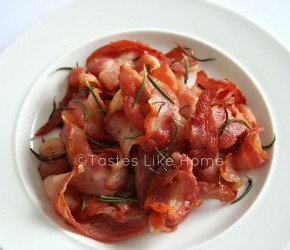Hi Everyone, Smoky, salty, fatty, crispy, bacon is all that and more. It is undeniably the number one breakfast meat that gets our tummies growling. Loudly. Just the aroma of bacon sizzling in a pan can make the strongest, weak. Bacon awakes in us a hunger that cannot be explained or denied. It’s like forbidden love.
While bacon can be made with the meats of various animals, it is the traditional bacon made of the pig’s belly that is the most revered, alluring and enticing. Considered to be one of the cheapest cuts of pork, the belly, becomes one of the most expensive foods when it is transformed through the application of curing. Woven like lace and layered with alternating bands of meat and fat, bacon is not just for breakfast anymore, it’s for all meals and everything in between. Over the last decade, bacon has been turned into jam, candy and desserts. Yes, who knew, bacon also has a sweet side.
I’m all for experimenting but I’m not a fan of the sweet side of bacon, I prefer all that is savoury of this age-old food that has been in existence for centuries. Once the production of local and rural communities, bacon is today produced in a large-scale commercial way. We can find bacon boasting of different flavours of smoking and curing methods. The addition of herbs and spices to the curing and cooking processes further imbue the meat with flavour. Slab, thick-cut or regular are all scales upon which we can buy our bacon. Or, you can make your own too. Actually, many people these days (yours truly included) have turned to the craft of making their own home-cured bacon.
How do you baconise? Baconise is not a real word, yet, but what I’m really asking you is, what are some of the ways in which you use bacon?
Bacon is a versatile meat and can be used in many ways. Grilled, pan fried or cooked in the oven, bacon can be eaten on its own or find itself layered as part of a sandwich such as a Bacon, Lettuce and Tomato (BLT). Lying beyond the edges of a burger patty it becomes a bacon burger. Any sandwich or burger with bacon is prized.

Cooked crisp and crumbled or chopped finely, bacon bits can be scattered over a variety of salads, dropped on top of soups and sprinkled on top of baked potatoes.
Savoury quick breads such as scones and cornbread benefit from bacon. Pies, tarts, and pizzas too. A creative way to use bacon for breakfast or brunch is to line the cups of a muffin pan with it and fill the cups with whisked or whole eggs.
Chopped and sautéed, bacon is a way to lure many people to eat their vegetables. Actually (unfortunately), it is the only way to get some people to eat their veggies.
It is not only the bacon meat itself that is yummy, so too is its drippings – the oil that renders from the cooked bacon. There is a ton of flavour in bacon fat that enhances everything to which it is added. Potatoes can be tossed with the drippings for roasting. It (bacon fat) can be used in place of oil to sauté many things, it can be added to rice dishes such as Fried Rice, Rice and Peas, Cook-up Rice, Pelau etc. In place of oil, bacon fat can be used to make vinaigrettes and salad dressings. In fact, you can use the melted bacon fat pretty much the same way you would use oil.

A final word on cooking bacon. Most people, including myself, tend to cook bacon on the stovetop. I just want to say that when doing so it is not necessary to add oil to the pan to cook the bacon because the bacon will yield its own oil. Here’s how to cook it:
- Start with a cold pan and layer the strips of bacon in a single layer across
the pan.
- Put the pan on top of the stove over medium heat. When the pan heats up
and the bacon starts to yield water, reduce the heat a little and let the bacon
cook until all the liquid dries out and the bacon starts to render its fat and
brown.
- Turn the bacon over to cook and brown on the other side then drain well on
paper towels.
- Always cook the bacon to your preferred way – some people like their bacon
very brown and entirely crispy while other want it somewhat brown and
moderately crispy.
- If you are using a dried cured bacon, the same process is used, the only thing
is that the bacon will brown faster and not yield any water (that’s because it
was not wet-cured in a brine).
- Drain the cooled grease in a bottle and store in the refrigerator. The fat will
congeal in the cool but quickly soften at room temperature and melt
completely when heated.
So I ask again, how do you baconise?
Cynthia




